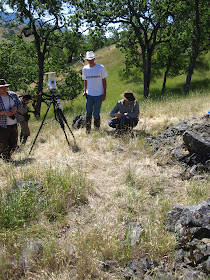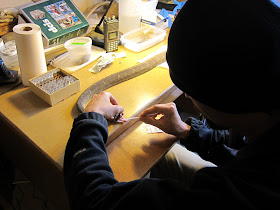I am lucky that I am able to use biorobotics in my research. This means that I can actually test the hypotheses we have about squirrel tail-flagging. Currently, all we know about tail-flagging is based off of observations of live squirrels interacting with snakes, but in order to test the true function of this behavior, we need to manipulate the tail-flagging signal. We obviously can't do this with live squirrels (for logistical and ethical issues), but thanks to a collaboration with
engineers at UC Davis, we can use Robosquirrel instead. We are using Robosquirrel to test how snakes perceive and respond to the displays made by ground squirrels.
In the wild, once squirrels detect a snake they will approach it and tail flag (move their tails back and forth). Additionally, squirrels heat up their tails (increase the thermal signature) in response to rattlesnakes (which sense infrared heat using pits on the sides on their heads), but they do not do this in response to gopher snakes (which cannot sense infrared heat). We want to know if heat truly is important in this display. Does it decrease the snake's ability to pin-point a strike? Does it make the squirrel look bigger? Does it help the snake "see" tail-flagging better, especially if it is dark out?
Also, what does the tail-flagging do for the squirrel? Does it communicate something to the snake? Does it prevent the snake from striking? Does it make the snake abandon the area? By presenting Robosquirrel to snakes with and without tail-flagging, and with and without infrared heat, we hope to answer some of these questions.
Robosquirrel at the end of its track. We glued grass to the track to conceal the metal box that hides the electrical wires under the robot.
The robosquirrel experimental setup. We lay down the track to within 30cm of a snake burrow. We set up a blind and wireless security camera to watch the snakes stealthily. Once the snake emerges and assumes ambush position we are ready to roll robosquirrel into position and give a display.
Robosquirrel ready for action!

The synchronized tail flag dance


















